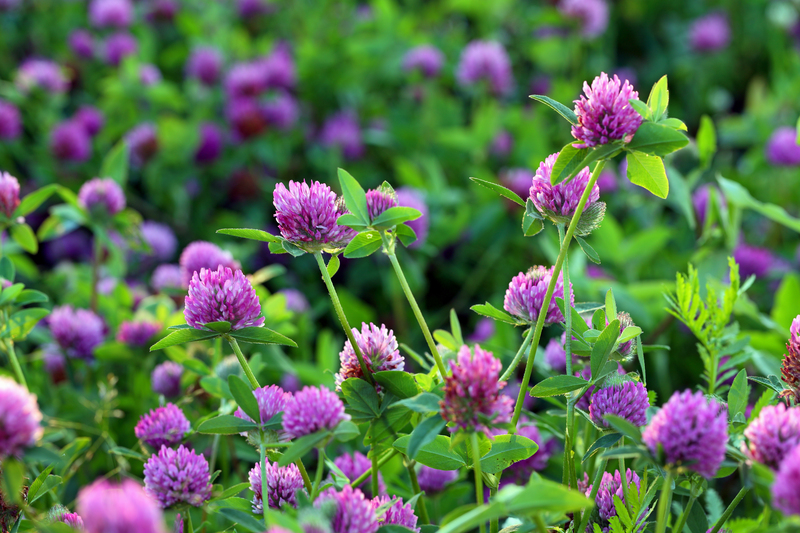Master the Art of Herb Garden Cultivation
Posted on 24/05/2025
Master the Art of Herb Garden Cultivation
Are you passionate about fresh flavors, sustainable living, or simply seeking a new gardening adventure? Herb garden cultivation is not only rewarding but also surprisingly accessible for gardeners of all skill levels. This comprehensive guide will help you master the art of herb gardening, whether you're transforming a windowsill or curating an abundant outdoor oasis. Explore essential steps, tips, and techniques to cultivate a flourishing herb garden and elevate your culinary and wellness experiences.

Why Grow an Herb Garden?
- Freshness and Flavor: Home-grown herbs deliver unmatched aroma, taste, and nutrition.
- Cost-Effective: Reduce your grocery bill by harvesting what you need, when you need it.
- Health and Wellness: Cultivate medicinal and culinary herbs for natural remedies and healthy meals.
- Sustainable Lifestyle: Home herb gardens minimize packaging waste and food miles.
- Aesthetic Appeal: Herbs add greenery and scent to any space, enhancing your home's ambiance.
Choosing the Best Herbs for Your Garden
As you embark on the journey of herb garden cultivation, choosing the right herbs is crucial. Not all herbs are created equal in terms of growing conditions or culinary uses. Consider these factors:
- Climate Compatibility: Mediterranean herbs like rosemary and thyme thrive in sun and dry soil, while mint and parsley prefer cooler, moister conditions.
- Usage: Select herbs based on your cooking preferences, medicinal interests, or ornamental value.
- Growth Habits: Some herbs, like basil and cilantro, are fast-growing annuals, while others, such as sage and lavender, are long-lived perennials.
Top 10 Essential Herbs for Beginners
- Basil (Ocimum basilicum)
- Parsley (Petroselinum crispum)
- Mint (Mentha spp.)
- Chives (Allium schoenoprasum)
- Rosemary (Salvia rosmarinus)
- Thyme (Thymus vulgaris)
- Sage (Salvia officinalis)
- Cilantro/Coriander (Coriandrum sativum)
- Dill (Anethum graveolens)
- Oregano (Origanum vulgare)
Planning Your Herb Garden Layout
Effective herb garden design ensures healthy plants and easy harvesting. Here's how to plan:
Site Selection
- Sunlight: Most herbs require 6-8 hours of direct sunlight. Observe your space and choose a sunny location.
- Soil Drainage: Herbs dislike soggy soil. Well-drained soil is essential, especially for Mediterranean varieties.
- Accessibility: Place frequently used or delicate herbs near your kitchen or a path for convenience.
Garden Styles
- Container Herb Gardens: Perfect for balconies, patios, or windowsills. Use separate pots for invasive species like mint.
- Raised Beds: Improve drainage and control soil quality. Group herbs with similar watering needs together.
- Traditional Plots: Allocate a section of your garden or yard for an in-ground herb bed.
- Vertical Gardens: Space-saving and decorative, ideal for small urban spaces. Try hanging baskets or wall-mounted planters.
Soil Preparation for Optimal Herb Growth
Proper soil preparation is the foundation of herb gardening success. Healthy, fertile soil ensures vigorous growth, robust flavor, and resistance to pests and diseases.
Soil Type and Amendments
- Soil Texture: Sandy loam is optimal, ensuring both fertility and good drainage.
- Organic Matter: Mix in well-rotted compost or aged manure to boost nutrients and moisture retention.
- pH Level: Most culinary herbs prefer a slightly acidic to neutral pH (6.0-7.0). Test and adjust if needed.
Drainage Solutions
- Raised beds and containers: Fill with quality potting mix and monitor for waterlogging.
- In-ground beds: Improve heavy clay soils by incorporating sand, compost, or organic material.
Planting Your Herb Garden: Seeds or Seedlings?
Deciding between starting from seeds or purchasing seedlings is a vital step in herb garden cultivation:
- Seeds: Economical and offer a wide variety. Some herbs (basil, dill, parsley) are easily started from seed.
- Seedlings: Jumpstart your garden and avoid the challenges of germination. Ideal for perennial herbs or those with slow or erratic germination (rosemary, thyme).
Sowing and Transplanting Tips
- Timing: Sow seeds indoors 4-6 weeks before the last frost or directly outdoors after danger of frost has passed.
- Spacing: Allow adequate room between plants for airflow and mature growth. Consult seed packets for guidelines.
- Watering: Keep soil moist but not soggy for germinating seeds. Avoid overwatering established plants.
Essential Care Practices for Flourishing Herbs
To truly master the art of herb cultivation, attention to regular care and mindful observation is key. Here's how to nurture your herb plants:
Watering Needs
- Consistency: Most herbs prefer even moisture but dislike having "wet feet." Water when the top inch of soil is dry.
- Mulching: Apply organic mulch (straw, shredded leaves) to conserve moisture, reduce weeds, and regulate soil temperature.
Fertilizing and Nutrition
- Minimal Feeding: Herbs grown in nutrient-rich soil rarely need extra fertilizer. Overfeeding can reduce flavor.
- Balanced Fertilizer: If needed, apply a diluted, balanced organic fertilizer monthly during the growing season.
Pruning and Harvesting Techniques
- Regular Harvesting: Frequent trimming encourages lush, bushy growth. Never remove more than a third of the plant at a time.
- Pinch Flower Buds: Removing flowers from annual herbs (basil, cilantro) prolongs leaf production and delays bolting.
Pest and Disease Management
- Integrated Pest Management (IPM): Hand-pick pests, encourage beneficial insects, and use organic solutions like neem oil or soap spray as needed.
- Avoid Overcrowding: Proper spacing and airflow help prevent fungal diseases and mildew.
Year-Round Herb Gardening: Indoors and Outdoors
Herb garden cultivation doesn't have to stop with the seasons. With the right approach, you can enjoy fresh herbs all year long!
Overwintering Hardy Herbs
- Perennials: Rosemary, sage, thyme, and chives often survive mild winters outdoors with mulch protection.
- Containers: Move potted herbs indoors or into sheltered areas before the first frost.
Indoor Herb Garden Tips
- Lighting: Place pots on a sunny south-facing windowsill or use full-spectrum grow lights for 10-12 hours per day.
- Temperature: Most herbs thrive indoors at 60-70?F (16-21?C).
- Air Circulation: Ensure good airflow to deter pests and diseases.
Creative Ideas for Herb Garden Success
Innovative Herb Garden Designs
- Spiral Herb Garden: Construct a spiraling mound with rocks and soil - maximizes space and creates distinct microclimates.
- Pallete Planters and Vertical Walls: Repurpose old pallets or use vertical kits to grow multiple herbs in small spaces.
- Hanging Baskets: Suspend trailing herbs like thyme or oregano in decorative baskets from porches and patios.
Themed Herb Gardens
- Culinary Herb Garden: Focus on your favorite kitchen herbs--basil, parsley, chives, rosemary, thyme, and oregano.
- Tea Herb Garden: Cultivate chamomile, mint, lemon balm, and lavender for soothing infusions.
- Medicinal Herb Garden: Grow echinacea, calendula, and feverfew for traditional home remedies.
- Pollinator Herb Patch: Attract bees and butterflies with borage, chives, and flowering mint.
How to Harvest, Preserve, and Use Your Herbs
Your dedication to herb cultivation will soon be rewarded with abundant harvests. Maximize their flavor, aroma, and benefits with these techniques:
Harvesting Tips
- Time It Right: Harvest in the morning after dew dries but before the heat of day intensifies essential oils.
- Tender Shoots: Pick young, tender leaves for best flavor. Avoid damaged or diseased parts.
Preservation Methods
- Drying: Hang bundled stems upside down in a cool, dark, airy place. Store in airtight containers away from light.
- Freezing: Chop herbs and freeze in ice-cube trays with water or oil for quick, easy use in recipes.
- Infusions: Make flavorful herbal oils, vinegars, or teas to capture essence long after harvest.
Culinary and Wellness Uses
Experiment with:
- Fresh Seasoning: Add chopped herbs to salads, soups, marinades, and sauces.
- Herbal Teas: Brew mint, chamomile, or lemon balm for calming infusions.
- Natural Remedies: Use sage for sore throat gargles, or rosemary for invigorating hair rinses.
- Crafts: Create fragrant sachets, essential oils, and culinary gifts from your edible harvests.
Common Challenges and Troubleshooting Tips
- Leggy Plants: Provide more sunlight and pinch back growing tips regularly.
- Yellow Leaves: Check for overwatering, poor drainage, or lack of nutrients.
- Wilting: Can result from drought, root rot, or pests. Diagnose quickly for best results.
- Slow Growth: Confirm sufficient light and nutrients. Transplant outgrown pots if needed.

Expert Tips for Herb Garden Cultivation Mastery
- Record Keeping: Keep a garden journal to log varieties, planting dates, and observations for continual improvement.
- Succession Sowing: Stagger planting times for herbs like cilantro and basil to enjoy fresh leaves longer.
- Companion Planting: Pair herbs strategically--basil repels tomato pests, and chives deter carrot flies.
- Patience and Experimentation: Every garden is unique, so don't be afraid to try new layouts, varieties, and techniques.
Conclusion: Grow with Confidence and Creativity
To master the art of herb garden cultivation is to open a world of flavor, fragrance, health, and beauty at your fingertips. With the right planning, care, and a touch of creativity, you'll nurture an herb garden that thrives season after season. Whether you're a beginner growing on a sunny windowsill or an experienced gardener designing a lush backyard retreat, the joy of harvesting fresh herbs enhances everyday life.
Start your herb gardening journey today--embrace the process, savor the harvest, and discover the countless rewards of cultivating your own herbs!

